December 24
20 min. to read
How to Resize an Image with Popular Tools
Every photographer will encounter a time when they need to resize a picture. Sometimes a photo has to be a certain size in order to look good on a website or in print. There are different tools that you can use to resize photos quickly and easily. For example, Luminar Neo resizes pictures in only a few clicks, offering different size ratios and even a crop tool that lets you immediately resize pictures for particular uses, for example as a Facebook cover. Why not try Luminar Neo now?
Reasons for resizing
Size issues
One of the biggest issues with large photos is size. The larger the photo, the larger the file size. Sometimes you need to resize a photo to make it significantly smaller so it occupies less space and is easier to handle.
Fitting on a blog or website
Some websites and blogs require specific photo sizes. You can check online for the specific sizes of photos for different social media platforms and learn how to resize photos specifically for them. For example, the optimal Instagram photo is square. Learn to resize photos for Facebook with this helpful article. Always test how your photos will look before uploading them, especially to your portfolio website.
Speed
Smaller photos upload faster. If you need to upload a significant number of photos to a website, photo sharing storage, or the cloud, you’ll see that reducing the size will speed up the process significantly.
Printing
Some photos won’t look good when printed out at their original size. If you make custom photo albums for weddings or print portraits of clients to be hung on walls, learn how to resize images to make sure they look stunning in this format too.
What is resolution?
When we talk about resizing, people typically have questions about resolution. What does resolution mean and what does it have to do with resizing photos? An image viewed on-screen and in print will be of different sizes because of the resolution of the image. Understanding how resolution works can help you realize which settings to change when you resize an image.
Screen size
When you buy a monitor, you’re probably aware of the resolution of the screen. Screen resolution means how many pixels a monitor can display. A pixel is the smallest component of your image that contains a single color. A monitor with a screen resolution of 1280×800 pixels displays 1280 pixels along the X axis and 800 pixels along the Y axis. The higher the resolution, the more pixels an image contains, making it more detailed and the color gradients smoother.
For Windows, you can check the resolution of your screen by going to Start > Control Panel > Display > Settings. For Mac, choose System Preferences > Displays and select Resolution: Scaled. It will show the default resolution of your screen.
Image size on-screen
Images are of a fixed pixel size when they appear on your display. Your display resolution determines how large the image appears on-screen. A display with a lower resolution displays fewer pixels than one with a higher resolution. Each pixel of a lower-resolution display is larger than each pixel of a higher-resolution display of the same physical size. Therefore, how you resize photos also depends on the resolution of your display.
Image sizes in print
The physical size of an image and its resolution determine the amount of data in the image and its print quality. In general, higher resolution images print at a higher quality.
Common sizes for photos
Learn how to resize pictures for printing. Consult the list below for standard sizes of photos in pixels. Resize an image to these dimensions according to your purpose.
- 320 x 240
- 640 x 480
- 800 x 600
- 1024 x 768
- 1280 x 1024
Quick guide on how to resize an image
What’s the best photo editing software for resizing pictures? What’s the best way to resize images?
Preview
Let’s find out how to resize an image in Mac’s Preview.
- Open your file in Preview.
- In the Tools menu, select Adjust Size.
- Just like in the box below, you’ll see the width and height of the image. Make sure to check the box next to Scale Proportionally and Resample Image.
- Change the width or the height to the dimension you need. The other dimension will change proportionally.
- When you’re done, click OK.
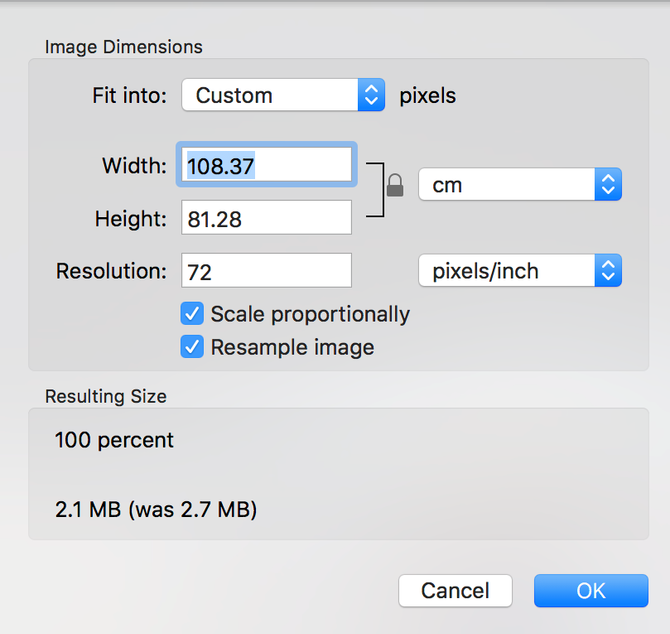
Photoshop
How can you resize images in Photoshop?
- Open Photoshop, go to File > Open and select an image.
- Go to Image > Image Size.
- An Image Size dialog box will appear (like the one pictured below).
- Enter new pixel dimensions, document size, or resolution.
- Before hitting OK to resize, you can also select the resampling method.
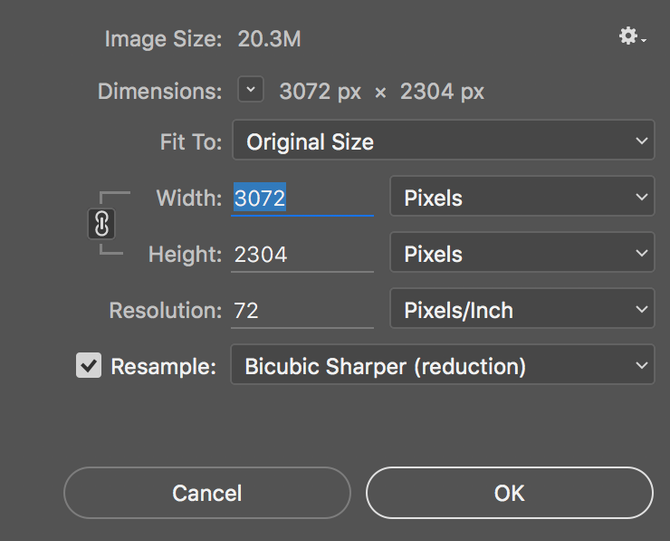
Bicubic (best for smooth gradients) calculates the averages of surrounding pixels.
Bicubic Sharper works best when reducing images while keeping details sharp. If an image appears too sharp, Bicubic is recommended.
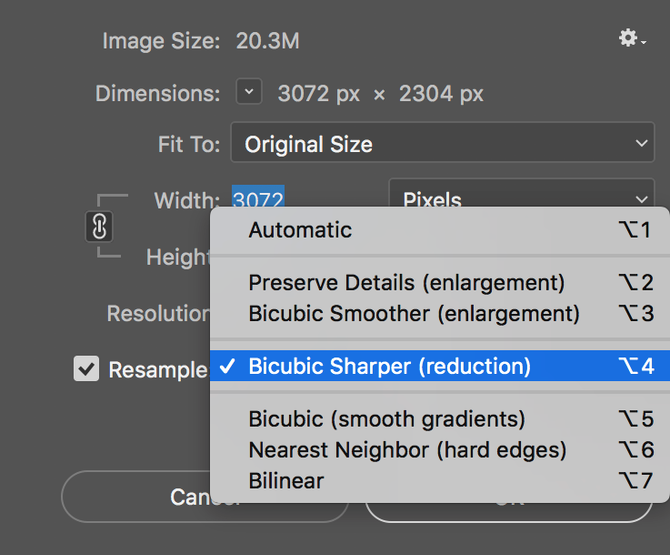
Lightroom
Resizing images in Lightroom isn’t very intuitive. To resize images, follow the steps below.
- Finish all your editing on the picture until you’re satisfied with the result.
- Click File > Export.
- A dialog box like the one below will open.
- Scroll down to Image Sizing and input the dimensions you need.
- Save your image by clicking Export.
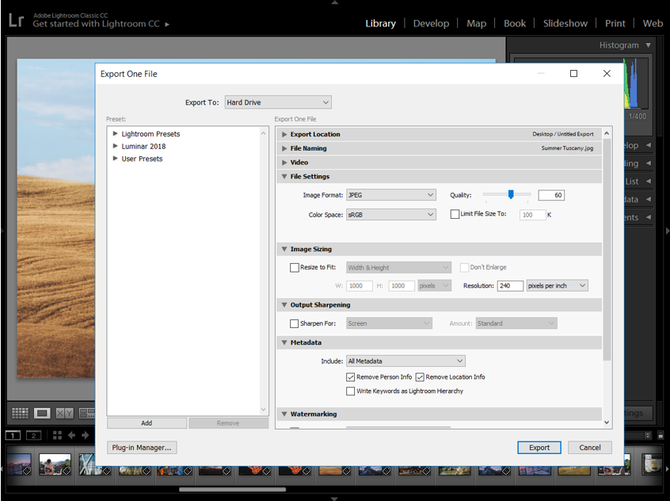 In Lightroom, you can create a custom preset of your preferred size. In order to do this, set the image size you want, then click the Add button below. A dialog box will appear allowing you to name your preset for future use.
In Lightroom, you can create a custom preset of your preferred size. In order to do this, set the image size you want, then click the Add button below. A dialog box will appear allowing you to name your preset for future use.
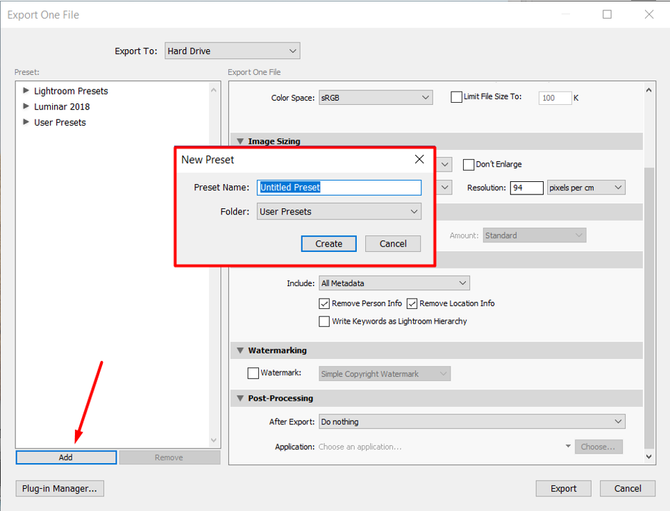
Luminar Neo
Resizing images in Luminar Neo is the quickest, most clutter-free way that doesn’t compromise on options. Here are some helpful instructions on how to resize the picture in Luminar Neo:
Step 1: Open an image in Luminar Neo.
Step 2: Navigate to Share to > Disk.
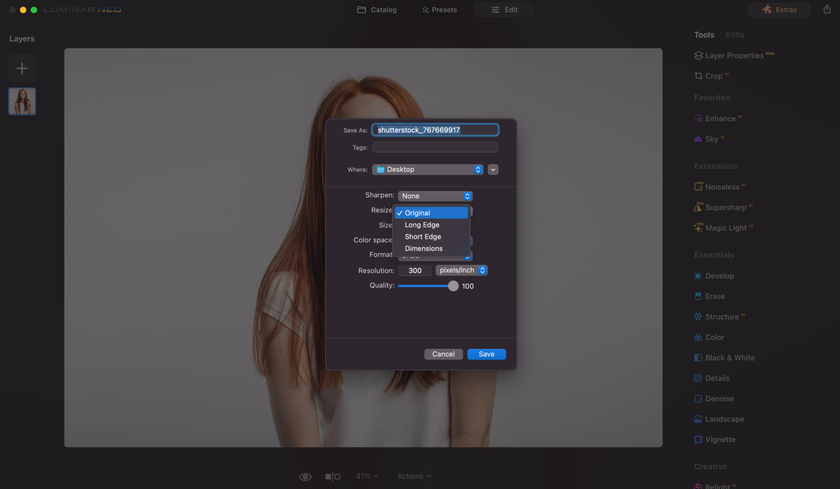
Step 3: Choose a resizing option:
Long Edge: Set the size of the longer edge, and the other will adjust proportionally.
Short Edge: Set the size of the shorter edge, and the other will adjust proportionally.
Dimensions: Input measurements for both edges.
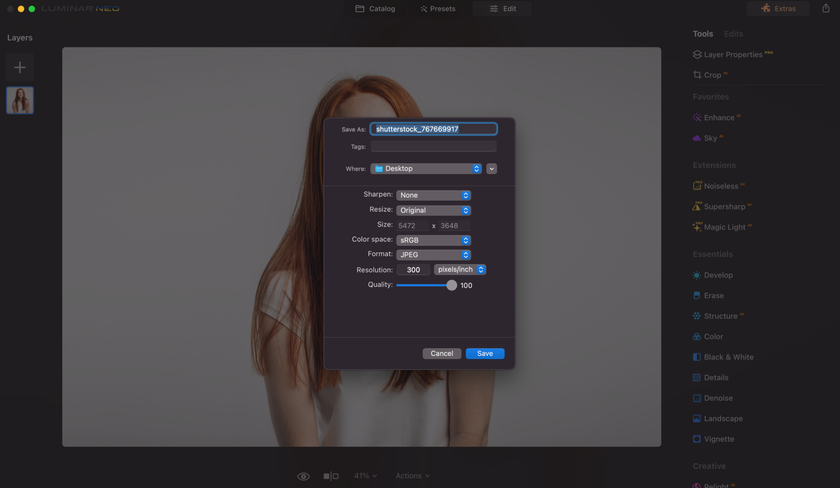
Step 4 (Optional): Adjust export settings such as:
Color profile (e.g., sRGB, Adobe RGB).
Format (e.g., JPEG, PNG).
Image quality (note: below 50% may degrade quality).
Step 5: Click Save. Rename or choose a new location if you don't want to replace the existing image.
How to Resize a Photo from Any Device: Windows, Mac, Phone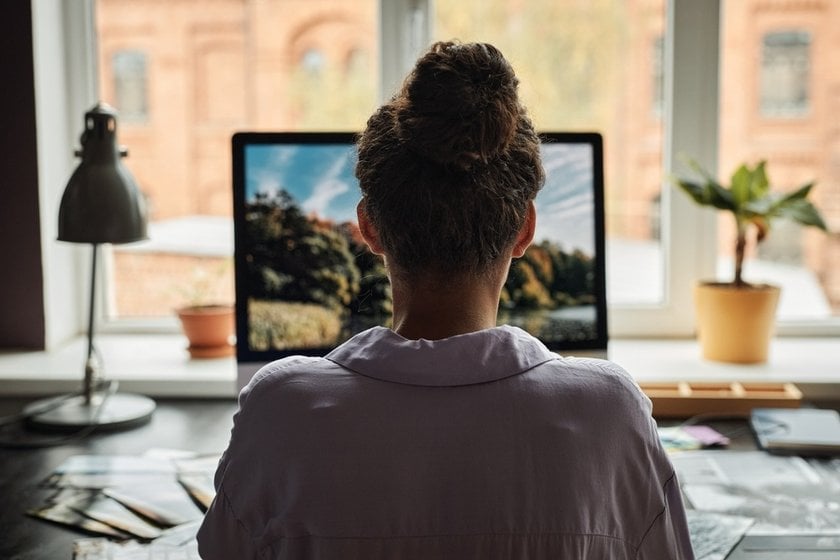
How do you resize a photo using only built-in apps? Here's the answer!
Resizing Images in Windows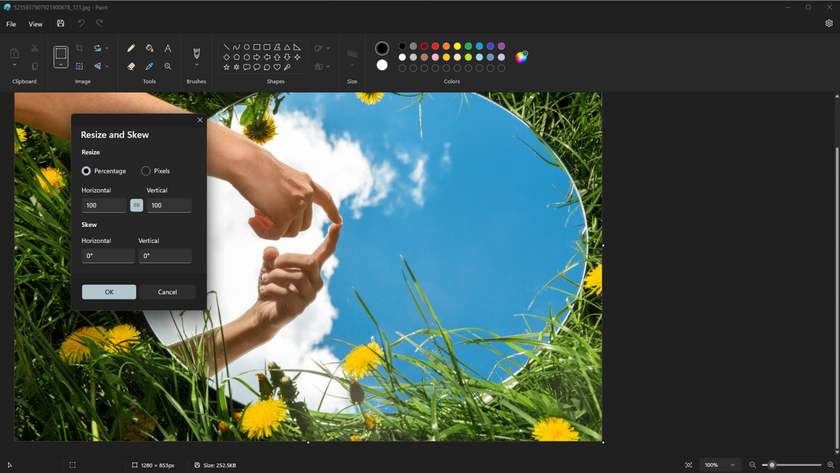
Step 1: Open the image with Microsoft Paint.
Step 2: Click on the Resize button in the toolbar.
Step 3: In the Resize and Skew dialog box, you can choose between Percentage and Pixels. Make sure to check the Maintain aspect ratio box to keep the proportions.
Step 4: Enter the desired size.
Step 5: Click OK and then save the image.
Resizing Images on a Mac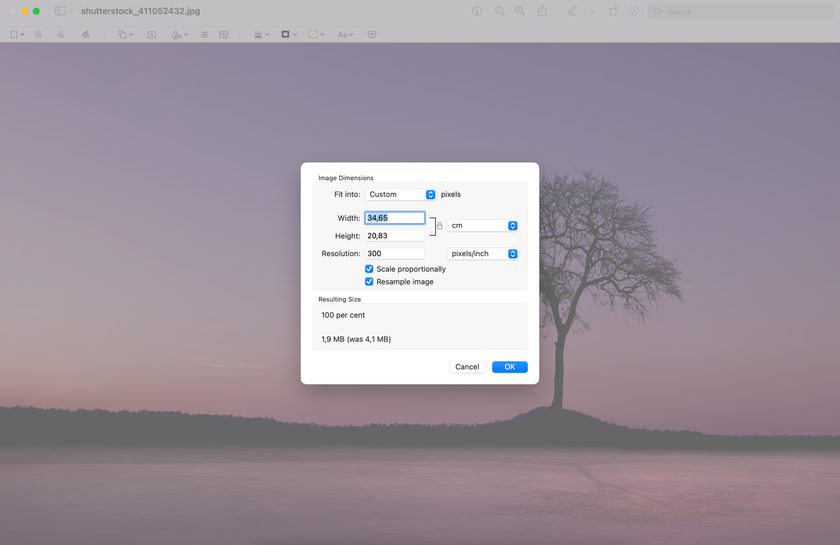
Step 1: Open your file in Preview.
Step 2: Navigate to the Tools menu and select Adjust Size.
Step 3: Check the boxes next to Scale Proportionally and Resample Image.
Step 4: Change either the width or the height. The other will adjust proportionally.
Step 5: Click OK to resize.
Resizing Images on Android
Step 1: Open Google Photos and select the image you want to resize.
Step 2: Tap on the edit icon (usually looks like sliders or a pencil).
Step 3: Tap on the Crop tool.
Step 4: Choose a predefined aspect ratio or adjust manually.
Step 5: Confirm the changes and save the edited image.
Note: There are various third-party apps available on the Google Play Store (like Photo & Picture Resizer) that provide more advanced resizing options.
Resizing Images on iPhone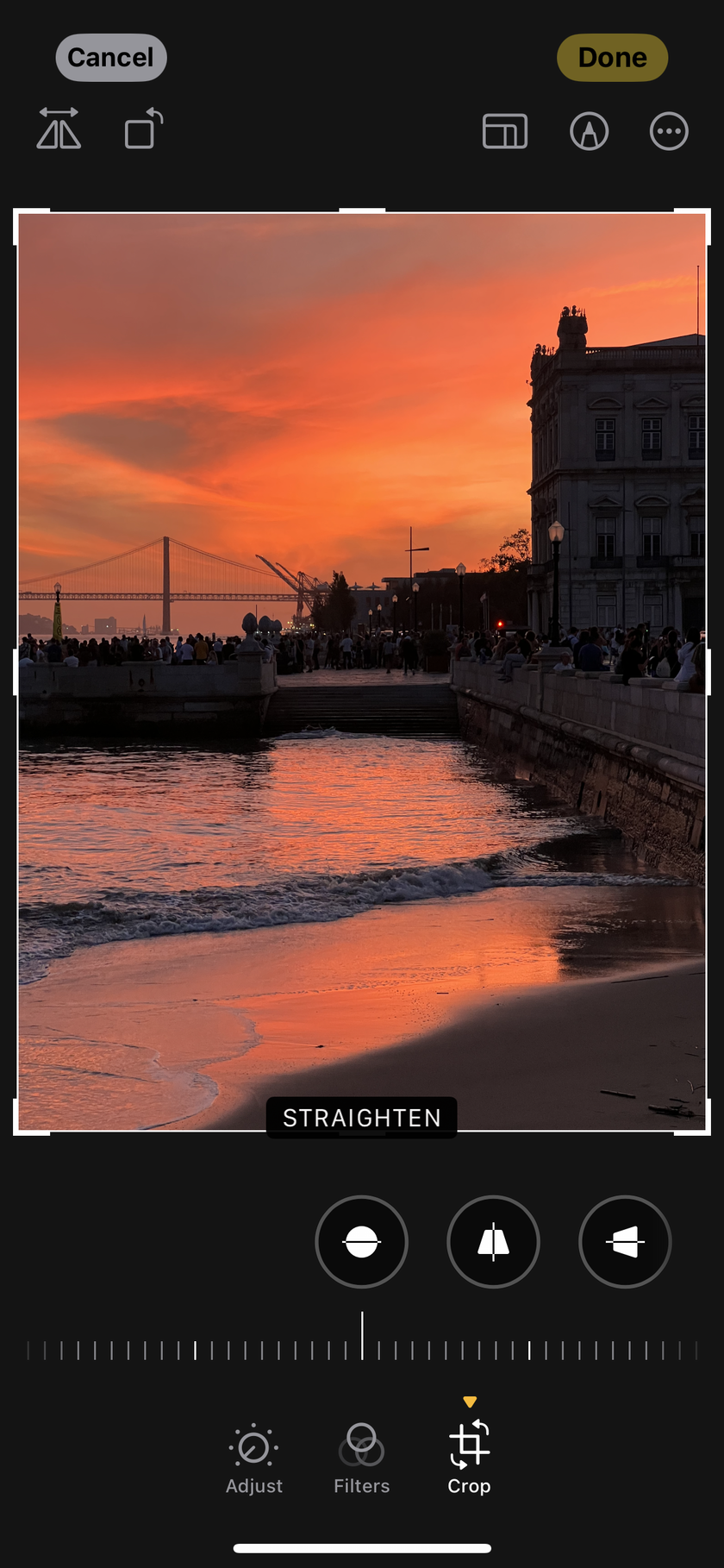
Step 1: Open the Photos app and select the image you want to resize.
Step 2: Tap on the edit icon (usually a three-sliders icon).
Step 3: Choose the Crop tool.
Step 4: Adjust the edges to resize, or select a predefined aspect ratio from the options.
Step 5: Confirm the changes by tapping on Done.
Note: For specific size adjustments, you might want to download third-party apps from the App Store like "Image Size" or "Resize It".
What is resolution?
When we talk about resizing, people typically have questions about resolution. What does resolution mean and what does it have to do with resizing photos? An image viewed on-screen and in print will be of different sizes because of the resolution of the image. Understanding how resolution works can help you realize which settings to change when you resize an image.
Screen size
When you buy a monitor, you’re probably aware of the resolution of the screen. Screen resolution means how many pixels a monitor can display. A pixel is the smallest component of your image that contains a single color. A monitor with a screen resolution of 1280×800 pixels displays 1280 pixels along the X axis and 800 pixels along the Y axis. The higher the resolution, the more pixels an image contains, making it more detailed and the color gradients smoother.
For Windows, you can check the resolution of your screen by going to Start > Control Panel > Display > Settings. For Mac, choose System Preferences > Displays and select Resolution: Scaled. It will show the default resolution of your screen.
Image size on-screen
Images are of a fixed pixel size when they appear on your display. Your display resolution determines how large the image appears on-screen. A display with a lower resolution displays fewer pixels than one with a higher resolution. Each pixel of a lower-resolution display is larger than each pixel of a higher-resolution display of the same physical size. Therefore, how you resize photos also depends on the resolution of your display.
Image sizes in print
The physical size of an image and its resolution determine the amount of data in the image and its print quality. In general, higher resolution images print at a higher quality.
Common sizes for photos
Learn how to resize pictures for printing. Consult the list below for standard sizes of photos in pixels. Resize an image to these dimensions according to your purpose.
320 x 240
640 x 480
800 x 600
1024 x 768
1280 x 1024
Wrap-Up
We hope this guide was beneficial, and you've grasped how to easily resize an image. Various software options offer image resizing capabilities, but it's pivotal to select one that aligns with your workflow and presents the best way to adjust image dimensions. This means having essential features that are straightforward to navigate and devoid of unnecessary clutter. If you're wondering how to resize an image to a specific size, Luminar Neo provides this functionality with a user-friendly interface, ensuring even novices can get accustomed rapidly. Ultimately, the right software should serve as a time-saving tool rather than a perplexing challenge.
FAQ
Which online tools do you suggest for image resizing?
There are several reputable online tools for image resizing. Some easiest ways to resize images:
ResizeImage.net: A straightforward tool that also allows you to crop, rotate, and change the format of the image.
TinyPNG/TinyJPG: While primarily known for compression, they also offer resizing capabilities.
PicResize: A versatile tool that provides several editing features in addition to resizing.
BIRME (Bulk Image Resizing Made Easy): Useful for resizing multiple images with a simple interface.
Simple Image Resizer: As the name suggests, it's a user-friendly platform that does the job without any hassle.
What software do you advise for resizing multiple images at once?
For batch resizing of multiple images, the following software is highly recommended:
Luminar Neo: Developed by Skylum, Luminar Neo stands out with its AI-enhanced photo editing tools. For batch resizing, users can easily navigate to the catalog, select the desired photos, and click the "Share to" button. The subsequent options allow for choosing the format and adjusting size settings, streamlining the process of resizing multiple images efficiently.
Adobe Photoshop: This leading photo-editing software offers powerful batch-processing tools. You can efficiently resize multiple images through its "Image Processor" or "Actions" features.
Lightroom: A staple for photographers, Lightroom's export options enable batch resizing while maintaining the desired quality and format for all images.
IrfanView: This is a free, lightweight, and versatile image viewer and editor. It's especially known for its batch conversion feature, which allows for resizing, format changing, and other multiple image adjustments.
FastStone Photo Resizer: This tool is both an image converter and a renamer. It offers an intuitive interface with a rich set of features for batch resizing and processing.
How does image resizing impact file size?
Resizing an image typically results in a change in the file size. If you decrease the dimensions of a picture, the file size will usually decrease because there are fewer pixels to store information for. Conversely, increasing the dimensions can lead to a larger file size, which might not add detail to the image and could make it look pixelated. The extent to which the file size changes also depends on the image format and the compression type applied.
How can I maintain high resolution when resizing images?
The best way to resize photos while maintaining high resolution is as follows:
Always start with the highest resolution original: It's always easier to reduce an image's size while maintaining quality than it is to increase its size.
Use the right software: Software like Luminar Neo uses advanced algorithms to resize images while retaining detail.
Avoid upscaling: Increasing an image's size can result in loss of clarity and detail. If you must upscale, consider using specialized software or plugins, like Upscale AI by Luminar Neo, which uses machine learning to upscale images while retaining quality.
Maintain aspect ratio: Always ensure the aspect ratio is locked when resizing to prevent the image from getting stretched or compressed.
Save in the right format: Some formats, like JPEG, are lossy and might lose quality each time they are saved. Formats like PNG or TIFF retain more detail.
Remember, while you can always decrease an image's size without much quality loss, increasing its size has limitations before quality is noticeably affected.
Click the button below to try Luminar Neo and learn how to resize pictures quickly and effectively.






 >
>

